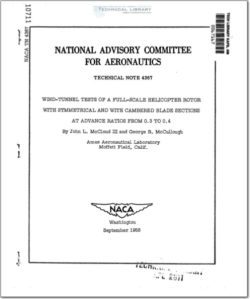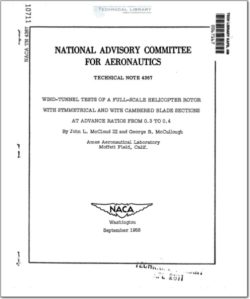NACA-TN-4367

- Version
- 167 Downloads
- 988.86 KB File Size
- 1 File Count
- March 24, 2016 Create Date
- March 24, 2016 Last Updated
National Advisory Committee for Aeronautics, Technical Notes - Wind-Tunnel Tests of a Full-Scale Helicopter Rotor with Symmetrical and with Cambered Blade Sections at Advance Ratios from 0.3 to 0.4

Wind-tunnel tests were made of a hhbfoot-diameter, three-bladed
helicopter rotor for the purpose of investigating the performance gains
made available by delaying retreating blade stall by the use of blade
sections with increased maximum lift. Marked changes in rotor-torque and
blade pitching—moment characteristics afforded two means of defining
stall boundaries of the rotor.
Comparison of these stall boundaries showed that the blades with
cambered sections were superior to the blades with symmetrical sections
in that the lifting capacity at a given forward speed was increased about
15 percent, or for equal lifts, forward speed capability was increased
20 to 25 percent.
For identical operating conditions within the capabilities of the
rotor with symmetrical blades, the rotor with cambered blades required
about 5 percent more power. Most of this increase probably was due to
an upper surface irregularity on the cambered blades.
The lifting capacity in forward flight and the maximum forward speed
of helicopters are limited aerodynamically by stalling of the retreating
rotor blades. Any method which increases the maximum lift and stalling
angle of the blade sections could be expected to increase rotor perform-
ance capabilities. An obvious solution would be to use cambered, high-
lift airfoil sections in the rotor blades. Although cambered sections
have been employed in a few rotors, designers have, in general, used
symmetrical sections because of their favorable high-speed and pitching-
moment characteristics In any case, direct comparisons of the forward
flight capabilities of rotors employing symmetrical and cambered blade
sections are lacking.
To determine whether the anticipated gains would be provided by the
use of cambered blade sections, tests were made in the Ames 40- by 80—foot
wind tunnel. Stall boundaries were determined for a hh—foot—diameter,
three—bladed helicopter rotor with two alternative sets of geometrically
similar blades. One set of blades, which served as the basis of compari-
son, had symmetrical sections, and the second set had sections with a
moderate amount of camber located well forward along the chord. Here-
after, these blades are referred to as symmetrical and cambered blades,
respectively. Methods for determining stall boundaries were also
investigated.
| File | Action |
|---|---|
| naca-tn-4367 Wind-Tunnel Tests of a Full-Scale Helicopter Rotor with Symmetrical and with Cambered Blade Sections at Advance Ratios from 0.3 to 0.4.pdf | Download |

Comment On This Post